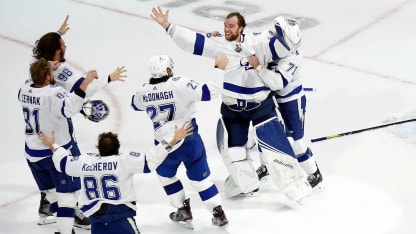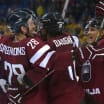En route to the Stanley Cup Final, the Lightning faced - and defeated - three of the best defensive teams in the NHL. In terms of fewest goals allowed per game during the regular season, the Columbus Blue Jackets finished third. The Boston Bruins were first. The New York Islanders ranked ninth - one place behind the Lightning - but their numbers were affected by a dip in their play during the second half of the regular season. Following the pause, the Islanders rediscovered the tight structure that had served them well at the start of the 2019-20 season. And arguably, by the time the Lightning played them in the Eastern Conference Final, the Islanders were defending even better than they had at any point pre-pause.
Mishkin's Musings: In Final, Lightning just played better than Stars
Tampa Bay found their game in the third period of the series-opening loss and went on to thoroughly dominate the remainder of the Cup Final

© BRUCE BENNETT/Getty Images
In order to have success against these well-structured teams, the Lightning needed to play with a similarly tight structure. They couldn't afford to allow these teams "easy" goals. That required a patient approach, one in which they wouldn't sacrifice defense for offense. But they still needed to generate offense against these clubs.
The Lightning found that formula. Strong puck management allowed them to possess the puck for a majority of time in all three of the series. During the isolated times when their puck management was shaky and they ceded possession, they defended hard without the puck and limited opposition scoring chances. And through their high-end skill, balanced attack, and strong forecheck, they were able to break down the team defenses of their first three opponents.
Given that they had to navigate past three excellent defensive teams through the first three rounds, perhaps it was fitting that the Lightning faced the Dallas Stars in the Stanley Cup Final. During the regular season, the Stars finished second in fewest goals allowed per game. And while they had played in some high-scoring games during the first two rounds of the playoffs, they clamped down defensively in the Western Conference Final. Against a dangerous Vegas team, the Stars allowed only eight goals in five games. So the challenge for the Lightning in the Final again would be to generate (and finish) chances against a strong defensive team and, at the same time, to play with patience, tight structure, and a commitment to terrific team defense themselves.
The Stars had four days between the end of the Western Conference Final and Game One of the Stanley Cup Final. The Lightning only got one day in between eliminating the Islanders and the start of the Dallas series. Their final two contests in the Eastern Conference Final had gone to overtime. The divergent schedules between the teams leading up to Game One seemed to play a role in how the opening contest unfolded. During the first two periods, the Stars looked crisp, sharp, and dialed in. Conversely, the Lightning seemed slow, both in their pace of play and decision-making. The Lightning were repeatedly bottled up through the neutral zone and struggled to go on the attack. When they dumped pucks into the Dallas end, their forecheck wasn't quick enough to force turnovers from the Stars defenders. Dallas got offensive contributions from defensemen throughout the playoffs and that trend continued in Game One. Joel Hanley and Jamie Oleksiak both jumped into the play and scored goals. Joel Kiviranta made it 3-1 with a rush tally in the final minute of the second period.
In the third period, the storyline changed. The Lightning shrugged off their doldrums and dominated the final 20 minutes. After posting a total of 14 shots in the first two periods combined, the Lightning fired 22 third period shots on net. They owned a staggering 43-3 advantage in shot attempts. Stars goalie Anton Khudobin was terrific in stopping all 22 shots - and the Stars added an empty-netter for a 4-1 final score - but the Lightning's dominant showing in the third left some unanswered questions. Was it due to the Lightning outplaying the Stars? Or was it more that Dallas, up by multiple goals, was content to sit back and protect the lead?
Those questions would eventually get answered as the series progressed. In every game - including the two contests that they lost - the Lightning had segments in which they completely took over the action. Sometimes those segments were 10 minutes. More often they were much longer than that. And sometimes there were multiple segments.
It happened twice in Game Two. The Stars got into early penalty trouble, taking three minor penalties in the opening period. The Lightning's power play, which entered the contest on an 0-14 skid, cashed in on the second and third chances. The Lightning made an adjustment on their power play entering Game Two, using a top unit of Brayden Point, Nikita Kucherov, Ondrej Palat, Alex Killorn, and Victor Hedman. During their second man advantage of the period, Killorn was able to walk from the side of the net to the front of the cage. Khudobin made a save, but the Lightning retrieved the puck and held it in the offensive zone. After Killorn's open look, the two Dallas defensemen on the PK kept closer to Killorn near the front of the net. That created room for Point in the slot. He took a pass from Kucherov and roofed the puck into the top of the net. Shortly thereafter, the Lightning got another power play and scored again. With the Stars penalty killers surrounding Point in the slot, Kucherov sold a shot from the right circle (freezing Khudobin) and wired a cross-ice pass to Palat. From the left circle, Palat had an open net. Including their first two goals, the Lightning controlled the final 10 minutes of the first. Kevin Shattenkirk's right point wrister found its way past Khudobin to extend the lead. But the Lightning generated a few other chances as well, including point blank looks for Pat Maroon and Palat.
In the second period, it would be the Lightning taking the penalties. Including an advantage that Dallas carried into the period, the Stars received five separate power play chances in the second. They scored on the fourth of those, cutting the Lightning lead to 3-1. The Stars were dangerous while on the man advantage - they posted 10 of their 18 second period shots while on the power play.
The Stars got another goal back early in the third, converting off the rush following an ill-timed Lightning line change and a coverage miscue in front of the net. But outside of the goal, the Stars generated virtually nothing in the third. (Jamie Benn had two good looks - he missed the net on one and Andrei Vasilevskiy stopped the other, which came with a sixth Dallas attacker on the ice.) Instead, the Lightning put on a puck management clinic. The Stars struggled to generate shots and chances in the third primarily because they didn't have the puck. The Lightning outshot the Stars, 12-5, in the third. Following the Mattias Janmark goal at 5:27, the Stars managed just two more shots on net for the rest of the game.
Game Three, of course, featured the dramatic return of captain Steven Stamkos. Buoyed by his addition to the lineup, the Lightning controlled the early minutes. Palat's neutral zone check on Miro Heiskanen led to a turnover and a Kucherov breakaway goal. Eighty-five seconds later, Victor Hedman (who had made a great defensive play to disrupt an early breakaway for Denis Gurianov) fed Stamkos down the right wing. Esa Lindell attempted a hip check, but Stamkos squeezed past him and finished an open look from the right circle. Even though Stamkos would only play two more shifts in the game, his presence in the lineup had an impact on his teammates. And his goal will go down as one of the most iconic of his career - and in Lightning history.
The Stars' best stretch in Game Three came shortly after the Stamkos tally. They got a power play, which ended prematurely when Kiviranta took an interference minor. But beginning with the shortened power play, extending into the four-on-four, and continuing through the Lightning power play, the Stars found their rhythm. Jason Dickinson scored shorthanded and the Stars generated several chances once back at five-on-five. In all, Dallas posted 14 shots during a span of seven and a half minutes. (The Stars would record only 10 shots in the other 52 and a half minutes of Game Three).
In the closing minutes of the first, the Lightning managed to end the Dallas momentum surge and level the ice. Then, with a power play chance that carried into the second, the Lightning re-established a two-goal lead and took over the game. Hedman's tally from the slot came at :54 of the second. By the time the period was over, the Lightning had outshot the Stars, 21-4, and had built a 5-1 lead. Though the Stars got one back in the third, the Lightning held Dallas to just four shots in the final frame.
Although they fell behind 2-0 in the first period of Game Four, the Lightning once again tilted the ice in that opening frame. The Stars got their two goals on just three shots. The Lightning were burned with a couple of coverage miscues on the tallies. Although on the opening goal, John Klingberg benefitted from a bounce when his initial shot was blocked, but the puck came right back to him. Most of action in the frame took place in the Dallas zone, but the Lightning didn't get rewarded until the final minute. Shattenkirk, Palat, and Point teamed up on a perfect passing sequence that began with Shattenkirk deep in the defensive zone. Point converted on a breakaway to pull the Lightning to within one. When Point scored again early in the second, the Lightning not only tied the game at two, they surged. Over the next several minutes, they applied heavy pressure, but couldn't get the lead. Instead, on an isolated counter, the Stars popped in the next one. That goal from Corey Perry at 8:26 gave the Stars a boost. They pushed hard over the next 10 minutes and came close to adding another. Vaslevskiy made a brilliant save on Nick Caamano, though, keeping the deficit at one. That proved to be crucial when Yanni Gourde tallied a power play goal late in the frame to tie the score again.
The third period was evenly-played and each team netted a goal. Vasilevskiy made another key save when he stopped Alexander Radulov's point-blank rebound chance late in the third.
Both teams had a power play opportunity in overtime. The Stars weren't happy with the call on Jamie Benn that led to the Lightning's power play. But the Lightning had a right to be upset with some of the calls that went against them, including an embellishment call late in the third on Point. That created a four-on-four, during which time the Lightning took their overtime penalty. So the Dallas PP included about a minute of four-on-three power play time. In the end, the Lightning killed off their penalty and the Stars didn't. Following a Gourde faceoff win in the offensive zone, Hedman fed Shattenkirk at the right circle. He whistled a low shot past a screened Khudobin to win the game.
Facing elimination in Game Five, the Stars delivered their best 60-minute performance of the series. Of course, the game went past regulation and the script was flipped in overtime. But for most of the first three periods, the Stars did well to prevent the Lightning from enjoying the dominating segments that had been a feature in the first four games. Prior to overtime, the best Lightning stretch came early in the second period following Palat's goal off the rush at 4:37 that tied the game at one. But when the Stars received a power play chance at 12:33, the Lightning surge ended. The Stars owned the better of the play through the end of the second. And even in the third, although the Lightning momentarily took the lead on Mikhail Sergachev's tally at 3:38, the Stars kept pressing. They were rewarded when Joe Pavelski lifted in a rebound goal at 13:15 to tie the game at two.
Outside of that eight-minute segment in the second period, the Lightning hadn't yet taken over play in Game Five. That changed, however, once overtime began. Essentially the whole first overtime was played in the Dallas end. The Lightning held the Stars to just two shots. And while they recorded only seven shots on net themselves in the frame, most of those required tough saves from Khudobin. Then there were the close calls that didn't result in shots on goal. The Lightning attempted 25 shots in the first OT, narrowly missing the net on some and having other great looks blocked by Dallas defenders.
The second overtime was more level and the Stars eventually won it when Perry knocked in his own rebound from the top of the crease.
The Lightning made two lineup changes for Game Six, inserting Zach Bogosian and Alex Volkov (making his postseason debut). Volkov made an immediate impact. In the first period, he hustled down the ice to negate an icing and, in the process, drew a penalty on Klingberg. During the ensuing power play, the Lightning scored the game's opening goal. Hedman started the sequence when he tracked a puck in the Lightning end and pivoted quickly back up ice. That crossed up Janmark, who fell and was momentarily out of the play. That left the Stars with only three penalty killers in position and the Lightning took advantage. Point accepted a feed from Kucherov and skated into the slot. He sold a pass to Hedman, which froze the Dallas defenders, and shot the puck on net. He jumped on the rebound and lifted it in. The Lightning's second goal came in the second period. With the Lightning needing a line change, the Stars tried a quick counter from their own end. But Maroon knocked down Radulov's saucer pass. Instead of a potential odd-man rush for the Stars, the Lightning countered on a three-on-two themselves. Blake Coleman finished a one-timer from the right circle to extend the lead.
The plays by Hedman and Maroon were key parts of the goals that the Lightning scored. But the biggest story of Game Six was how the Lightning defended. Through the first two periods, they dominated possession. They held the Stars to eight total shots. In the third, the Stars had more possession, but the Lightning defended tightly in their own end and limited chances. As it turned out, the two goals they scored in Game Six were more than enough.
For the Final, the teams were separated by only three goals. The Lightning scored 18 and the Stars netted 15. But the beyond that stat, the difference between the clubs was stark. The Stars had those aforementioned solid segments during the series, but those moments were isolated. For the vast majority of the series, the Lightning held an advantage. An advantage in possession, shots, attempts, and chances. Sometimes, when play was fairly level, it was a narrow advantage. On other occasions, the advantage was much wider. The Lightning would find a gear that Dallas simply couldn't match. They'd tilt the ice so severely that the Stars struggled just to get tired players off the ice. And the Lightning were able to find this gear repeatedly - putting on this kind of possession display for a portion of every game.
There were other keys to the series, of course. The Lightning's line of Point, Kucherov, and Palat overwhelmed the Stars. For most of the Final, that line played with the puck in the offensive zone. And they contributed offensively - the three players combined for 21 points in the series.
Then there was the special teams battle. Though the Stars did produce some dangerous power play chances through the six games, they finished the Final scoring just one power play goal. At the other end, the Lightning netted seven power play goals. They were big goals, too. The opening two tallies of Game Two. Hedman's Game Three strike that launched the Lightning's dominant second period. In Game Four, the Lightning twice tied the game with power play goals and the third power play marker was Shattenkirk's OT tally. Their final power play goal opened the scoring in Game Six and turned out to be the game-winning, Cup-clinching goal.
And finally, they (once again) defended very well in the Final. Throughout the series, the Lightning kept the Dallas chances to a minimum. They never did sacrifice defense for offense. That was never more true than in the final game. During a playoff run in which they put an emphasis on patience, structure, and team defense, the Lightning clinched the series and captured the Stanley Cup with a defensive masterpiece - one of the best in franchise history.


















